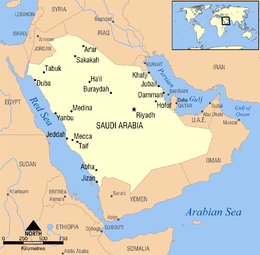Unification of Saudi Arabia
| Unification of Saudi Arabia | ||||||||
|---|---|---|---|---|---|---|---|---|
 Present Saudi state (Saudi Arabia) |
||||||||
|
||||||||
| Belligerents | ||||||||
|
|
|
|
||||||
| Commanders and leaders | ||||||||
|
|
|
|||||||
| Strength | ||||||||
| 38,000 | 77,000 | 23,000 | ||||||
| Casualties and losses | ||||||||
| Unknown | Unknown | |||||||
| 8,000+ killed in total | ||||||||
Saudi takeover of central and northern parts of Arabia:
The unification of Saudi Arabia was a military and political campaign, by which the various tribes, sheikhdoms, emirates, and kingdoms of most of the Arabian Peninsula were conquered by the House of Saud, or Al Saud, between 1902 and 1932, when the modern-day Kingdom of Saudi Arabia was proclaimed under the leadership of Ibn Saud, creating what is sometimes referred to as the Third Saudi State, to differentiate it from the Emirate of Diriyah, the First Saudi State and the Emirate of Nejd, the Second Saudi State, also House of Saud states.
The Al-Saud had been in exile in British protected emirate of Kuwait since 1893 following their third episode of removal from power and dissolution of their polity, this time by the Al Rashid emirate of Ha'il. In 1902, Ibn Saud recaptured Riyadh, the Al Saud dynasty's former capital. He went on to subdue the rest of Nejd, Al-Hasa, Jebel Shammar, Asir, and Hejaz (location of the Muslim holy cities of Mecca and Medina) between 1913 and 1926. The resultant polity was named the Kingdom of Nejd and Hejaz from 1927 until it was further consolidated with Al-Hasa and Qatif into the Kingdom of Saudi Arabia in 1932.
...
Wikipedia
